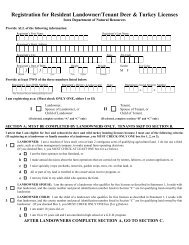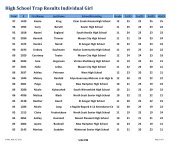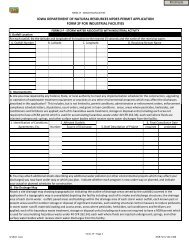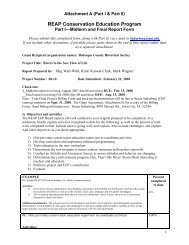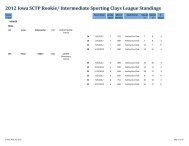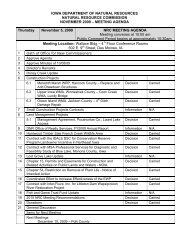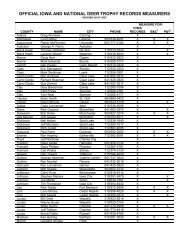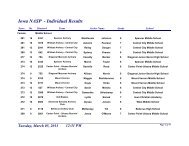3 Dams and River Ecology - Iowa Department of Natural Resources
3 Dams and River Ecology - Iowa Department of Natural Resources
3 Dams and River Ecology - Iowa Department of Natural Resources
Create successful ePaper yourself
Turn your PDF publications into a flip-book with our unique Google optimized e-Paper software.
Mussel restoration efforts<br />
Native mussels are intimately connected with fish <strong>and</strong> fish migrations. Known to many <strong>Iowa</strong>ns as clams – they may be<br />
<strong>of</strong> increasing popular interest to <strong>Iowa</strong>ns as they learn more about their habits <strong>and</strong> life cycle. Mussels reproduce <strong>and</strong><br />
spread their young, called glochidia, via fish hosts through an astonishing variety <strong>of</strong> means. Some, such as the pocketbook<br />
mussel, have modified mantle tissue that serves as a fish “lure,” which attracts fish near. It then sprays glochidia,<br />
some <strong>of</strong> which attach to the fish gills <strong>and</strong> move to new waters where the fish will spawn. Others wait with shells open<br />
in ambush. When a small fish like the logperch that forages by dislodging pebbles gets too near, the mussel clamps<br />
down <strong>and</strong> holds the small fish, injecting it with glochidia. (Barnhart, 2008)<br />
<strong>Iowa</strong>’s mussels filter feed on tiny organisms such as phytoplankton <strong>and</strong> bacteria. (Heidebrink, 2002). A typical mussel<br />
can filter several gallons <strong>of</strong> water a day, <strong>and</strong> some can filter up to 10 gallons per day. If they are not overwhelmed with<br />
sediments, healthy mussel beds can clarify water <strong>and</strong> filter bacteria (Machtinger, 2007).<br />
About 12 species <strong>of</strong> mussel supported a post-settlement button industry beginning in 1891. By 1910 there were 70<br />
factories centered in Muscatine, employing 3,376 <strong>Iowa</strong>ns for a total product value <strong>of</strong> $4 million in 1910, equating to<br />
about $90 million today. However, the economic boon for eastern <strong>Iowa</strong>ns rapidly decimated mussel populations. As<br />
early as 1898, mussels had to be imported from Missouri <strong>and</strong> Illinois because <strong>of</strong> “overfishing, made worse by pollution,<br />
depleting the supply <strong>of</strong> oxygen in the rivers” (Annals).<br />
In recent years, the story <strong>of</strong> mussels has been one <strong>of</strong> declining populations <strong>and</strong> potential extirpation <strong>of</strong> a number <strong>of</strong><br />
species from <strong>Iowa</strong>. Unfortunately, they fall victim to a variety <strong>of</strong> today’s stresses on streams. Stressors may include excessive<br />
<strong>and</strong> overly frequent channel scour events that re-locate the animals to inopportune places or bury them under<br />
sediments, exessive nutrients or low dissolved oxygen, <strong>and</strong> an inability to re-polulate after events such as chemical<br />
spills. Mussels <strong>of</strong> greatest conservation need are identified in the <strong>Iowa</strong> Wildlife Comprehensive Plan.<br />
GIS modeling was used to compare fish host <strong>and</strong> mussel presence datasets to indicate study areas for recovery (Figure<br />
3-c) <strong>and</strong> potential re-colonization <strong>of</strong> mussels identified as species <strong>of</strong> greatest conservation need (SGCN). An attempt<br />
was made to examine segments upstream <strong>of</strong> dams where both mussels <strong>and</strong> known fish hosts (Kurth, 2009) had not<br />
been sampled, but had been sampled in a segment downstream <strong>of</strong> the dam. Data was insufficient to find examples.<br />
In lieu <strong>of</strong> this, for calculating scores for biological priority (see Appendix C), proximity <strong>of</strong> SGCN mussels sampled near<br />
dams was used for prioritization. Sample sites for mussels are not as extensive or geographically balanced as they are<br />
for fish, but the map does outline areas worthy <strong>of</strong> consideration. If a dam is being considered for a fish passage project,<br />
additional mussel sampling should be conducted within the project scope. In the future, study is needed to verify that<br />
fish hosts <strong>and</strong> their glochidia take advantage <strong>of</strong> access to upstream reaches. In addition, the immediate project area<br />
should be surveyed for mussels by a qualified pr<strong>of</strong>essional to ensure that various species under population decline are<br />
not disturbed in the project area.<br />
Aquatic threatened <strong>and</strong> endangered species <strong>and</strong> river connectivity<br />
In addition to mussels, a number <strong>of</strong> fish species are also imperiled, <strong>and</strong> have been determined by state <strong>and</strong> federal<br />
authorities to warrant listing as a threatened <strong>and</strong> endangered species. <strong>Iowa</strong> administrative code (571—Chapter 77.2)<br />
defines animal species to be endangered, threatened or <strong>of</strong> special concern.<br />
State threatened <strong>and</strong> endangered species include:<br />
33<br />
Common Name Scientific Name<br />
<strong>Iowa</strong><br />
Abun.<br />
<strong>Iowa</strong><br />
Trend<br />
Elktoe Alasmidonta marginata U D<br />
Slippershell Alasmidonta viridis R D<br />
Flat floater Anodonta suborbiculata R D<br />
Cylinder Anodontoides ferussacianus R D<br />
Rock pocketbook Arcidens confragosus U D<br />
Spectacle case Cumberl<strong>and</strong>ia monodonta R D<br />
Purple pimpleback Cyclonaias tuberculata R/X D<br />
Butterfly Ellipsaria lineolata U K<br />
Spike Elliptio dilatata U D<br />
Ebonyshell Fusconaia ebena R D<br />
Ozark pigtoe Fusconaia ozarkensis X X<br />
Higgins’ eye pearlymussel Lampsilis higginsi R D<br />
Yellow s<strong>and</strong>shell Lampsilis teres anodontoides R D<br />
Slough s<strong>and</strong>shell Lampsilis teres teres R D<br />
Creek heelsplitter Lasmigona compressa R D<br />
Fluted shell Lasmigona costata R D<br />
Pondmussel Ligumia subrostrata X NA<br />
Hickorynut Obovaria olivaria U D<br />
Bullhead (Sheepnose) Plethobasus cyphus R D<br />
Round pigtoe Pleurobema sintoxia R D<br />
Monkeyface Quadrula metanerva U D<br />
Wartyback Quadrula nodulata U D<br />
Strange floater (Squawfoot) Strophitus undulatus R D<br />
Lilliput Toxolasma parvus R D<br />
Pistolgrip Tritogonia verrucosa R D<br />
Fawnsfoot Truncilla donaciformis R D<br />
Pondhorn Uniomerus tetralasmus R K<br />
Paper pondshell Utterbackia imbecillis R D<br />
Ellipse Venustaconcha ellipsiformis R D<br />
<strong>Iowa</strong> Abundance: A = abundant, C = common, U = uncommon, R = rare, K = unknown, X = possibly extirpated.<br />
<strong>Iowa</strong> Trend: K = unknown, I = increasing, S = stable, D = decreasing.<br />
Table 3-a: Mussel Species <strong>of</strong> Greatest Conservation Need,<br />
status <strong>and</strong> trend.



